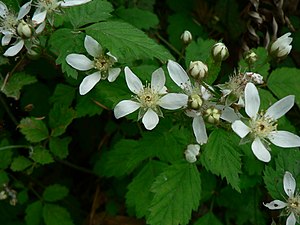Difference between revisions of "Rubus ursinus"
Jump to navigation
Jump to search
m (1 revision: From PNW foraging book - part 4) |
(cut down) |
||
| Line 23: | Line 23: | ||
|synonyms_ref = <ref name=tabby/><ref>{{GRIN | accessdate = 22 December 2017}}</ref> | |synonyms_ref = <ref name=tabby/><ref>{{GRIN | accessdate = 22 December 2017}}</ref> | ||
}} | }} | ||
| − | |||
| − | |||
| − | |||
| − | |||
| − | |||
| − | |||
| − | |||
| − | |||
| − | |||
| − | |||
| − | |||
| − | |||
| − | |||
| − | |||
| − | |||
| − | |||
| − | |||
| − | |||
| − | |||
| − | |||
| − | |||
| − | |||
| − | |||
| − | |||
| − | |||
| − | |||
| − | |||
| − | |||
| − | |||
| − | |||
| − | |||
| − | |||
| − | |||
| − | |||
| − | |||
| − | |||
| − | |||
| − | |||
| − | |||
==References== | ==References== | ||
{{Reflist|colwidth=30em}} | {{Reflist|colwidth=30em}} | ||
| − | + | {{Ack-Wikipedia}} | |
| − | |||
| − | |||
| − | |||
| − | |||
| − | |||
| − | {{ | ||
| − | |||
| − | |||
| − | |||
| − | |||
| − | |||
| − | [[Category:Rubus | + | [[Category:Rubus]] |
| − | + | [[Category:Plants Keenan has eaten]] | |
| − | |||
| − | |||
| − | |||
| − | |||
| − | |||
| − | |||
| − | |||
| − | [[Category:Plants | ||
| − | |||
| − | |||
| − | |||
| − | |||
| − | |||
| − | |||
| − | |||
| − | |||
| − | |||
| − | |||
| − | |||
| − | |||
| − | |||
Latest revision as of 19:05, 4 November 2018
| Rubus ursinus | |
|---|---|

| |
| Scientific classification | |
| Kingdom: | |
| (unranked): | |
| (unranked): | |
| (unranked): | |
| Order: | |
| Family: | |
| Genus: | |
| Subgenus: | Rubus
|
| Species: | R. ursinus
|
| Binomial name | |
| Rubus ursinus | |
| Synonyms[1][2] | |
References
- ↑ 1.0 1.1 The Plant List, Rubus ursinus
- ↑ [{{#property:P1421|}} "{{#Property:P225}}"] Check
|url=value (help). Germplasm Resources Information Network (GRIN). Agricultural Research Service (ARS), United States Department of Agriculture (USDA). Retrieved 22 December 2017.
Acknowledgements
This article uses material from the Wikipedia article Rubus ursinus, which is released under the Creative Commons Attribution-Share-Alike License 3.0.